 Eric Hunt, known on the forum as Whip_It_Out, resides in Texas and plays (as he descirbes it) a hilly, treeless, windy course known as Twin Creeks. At the time of the video captures seen in this article, Eric played to a 8.4 handicap on his home course. Eric’s misses tend to be off the toe of the club with the ball flying to the right of the intended target.
Eric Hunt, known on the forum as Whip_It_Out, resides in Texas and plays (as he descirbes it) a hilly, treeless, windy course known as Twin Creeks. At the time of the video captures seen in this article, Eric played to a 8.4 handicap on his home course. Eric’s misses tend to be off the toe of the club with the ball flying to the right of the intended target.
During this Swing Check we’ll look at his setup, backswing, and impact positions, and how each may encourage Eric’s blocked shots to the right of his target.
Setup
Looking at Eric’s setup, there are two noticeable areas that could account for him leaving the ball out to the right of his target. The first is his ball position, which looks too far back in his stance (as seen in the face-on iron setup). The second is his alignment which appears to be pointed far to the right (seen in the down-the-line driver setup). The red line in the face-on iron view shows where the ball is positioned relative to the body, and the green line indicates the desired ball position, and where it would be relative to the body. The white line along the ground illustrates the body alignment realtive to the target.
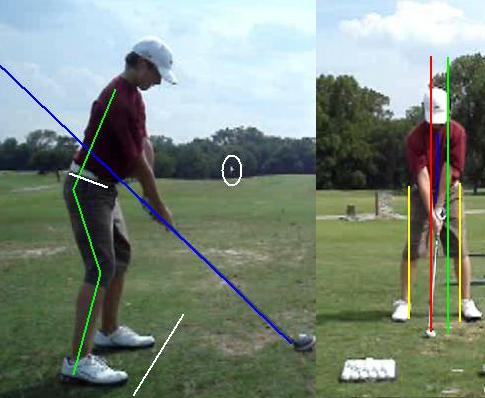
Playing the ball too far back in the stance can lead to aligning the body to the right of the target, a tilting of the upper spine toward the target, and encourage lateral motion during the swing. Eric’s ball position and shaft tilt (toward the target) at address will encourage him to swing the club under and inside the original shaft angle plane during the backswing. Each makes the swing more complicated than necessary and requires Eric to make compensations that will make it difficult for him to hit shots toward his targets.
When we compare Eric (iron face-on) to Charles Howell III (iron face-on) we see noticeable differences. Eric’s ball is positioned almost in line with his back ear, his shaft is tilted toward the target, and his upper body is leaning toward the target (as we can see his nose is closer to the target than his belt buckle/zipper). Howell has the ball positioned in line with his left ear, the shaft of the club is straight up and down (perpendicular to the ground), and his upper spine is tilted slightly away from the target. All of which helps Howell to make a good start to his backswing. The ball position, and shaft angle influence how and where the club is moved back during the takeaway. The spine tilt sets how balance and weight distribution will move during the swing.
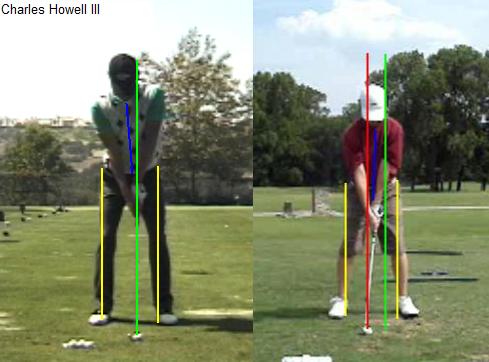
Ball position, spine angle, and alignment all have an influence on each other. Adjusting what we have seen from the face-on angle will also improve what we see from a down-the-line view. One other setup adjustment that might help Eric to start back a little better would be to increase his hip tilt (seen by the tilt of Eric’s belt line). More tilt (he’s not far from a good position here) will put the belt line closer to the original shaft plane line which will in turn promote a less flat start to the backswing. Tilting from the hips and getting the belt line matching the shaft plane line will encourage the back and the club shaft to form a right angle at setup. That right angle will encourage good body rotation and increase the chance of the shaft swinging back on a efficent path and parallel planes during the swing. After the slight setup adjustments we might have trouble telling him apart from Adam Scott at address. 😉
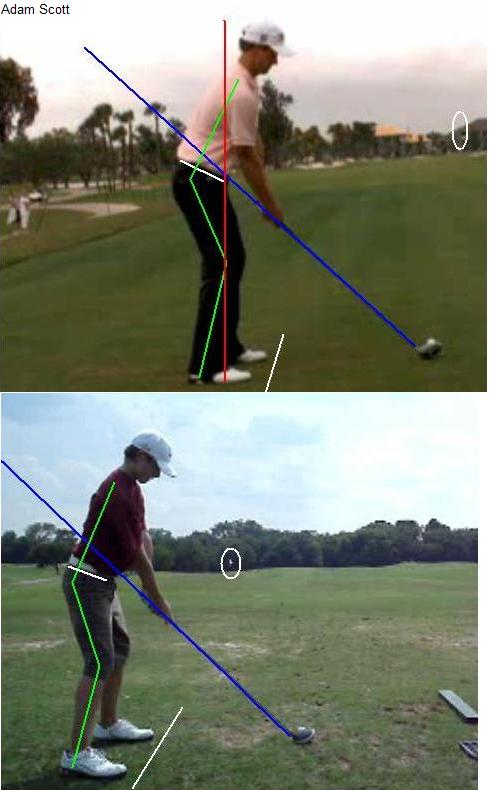
Backswing
Eric’s setup position has promoted an over-rotation of the hips and shoulders starting back, and a flattening of the shaft early in the backswing. Aligning farther left will mean the hips and shoulders will not be able to rotate as far away from the target. Restricting the hip turn will restrict the body motion, which which will reduce the likelihood of the arms swinging too deep behind the body. The improved setup (and a small reduction in hip rotation) could move Eric from his current backswing position to one closer to what we see in the image of Adam Scott.
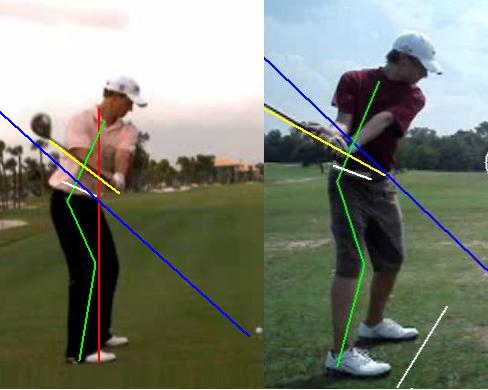
Top of Swing
As we reach the top of the swing we see that Eric’s left arm has arrived in a position nearly parallel to his belt line, and parallel to the position we saw the club in near hip high on the backswing. As we can see the same is true for Adam Scott’s swing. At the top of Scott’s swing the club shaft is parallel (or close to parallel) to his belt line tilt, and the original shaft angle plane. Each stage of the swing has influenced the positions we see at the next stage. By improving the early sections we should see improvements automatically occurring in the later stages.
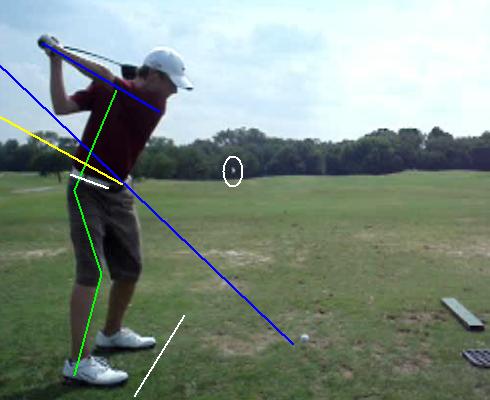
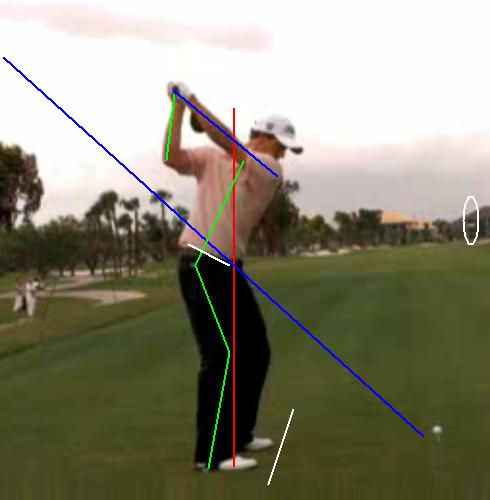
Impact
The improved setup and backswing position should lead to an improved impact position more along the lines of Adam Scott. Eric’s slight deviations have caused his body to loose its angles, and in turn caused the arms to be blocked upward and outward. With the arms and body moving toward the ball (shifting balance toward the toes) on the downswing pushes the club to swing on an outward path (to the right) increasing the likelyhood of the shot being blocked to the right.
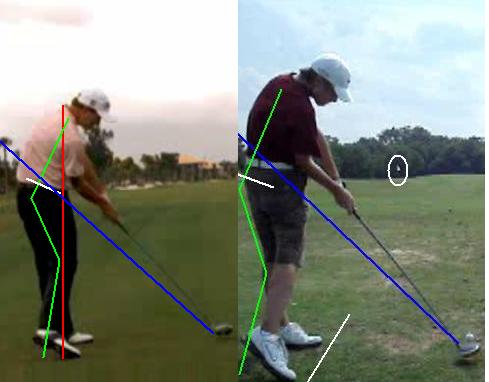
Eric’s setup changes may lead to a higher ball flight than he is accustom, but after a few rounds playing with it he’ll likely find that it is a stronger ball flight that is not as effected by the wind as his old shots once were. 🙂
If you’re interested in having your swing analyzed in a future edition of Swing Check here on The Sand Trap, check out the requirements page and submit your videos today!

Nice analysis. I appreciate the clear, point-by-point breakdown and explanation of how each element of his setup effects different aspects of the swing. For me it’s timely as well. I too have been pushing many of my shots and I notice some similarities with my setup as well as a flattening of my swing plane. I can’t wait to try this tomorrow.
I love reading these. Anything to help me better understand the golf swing I think I can benefit from. I’ve actually noticed that I’ve started to do some of the tips recently with great results. Mainly tilting my upper spine away from the target on my drives. I really need to work on this more with my irons, in particular my short irons.
This is a great series. Nice work, whoever thought of it.
Thanks so much, Tom. You showed some things I noticed before, but I didn’t knwo what to do about them so the little tips alnog the way really helped.